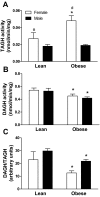Influence of gender, obesity, and muscle lipase activity on intramyocellular lipids in sedentary individuals
- PMID: 19531593
- PMCID: PMC2741707
- DOI: 10.1210/jc.2009-0053
Influence of gender, obesity, and muscle lipase activity on intramyocellular lipids in sedentary individuals
Abstract
Context: Obesity and type 2 diabetes are associated with elevated intramyocellular lipids (IMCLs) and insulin resistance.
Objective: We tested the hypothesis that skeletal muscle lipases activity could influence IMCL content (including diacylglycerol and ceramides).
Design and patients: The present study included 48 subjects with a wide range of age (19-68 yr) and body mass index (20-45 kg/m(2)) who underwent skeletal muscle biopsy, dual-energy x-ray absorptiometry and a hyperinsulinemic euglycemic clamp.
Main outcome measures: Insulin sensitivity by hyperinsulinemic clamp, and intramyocellular triacylglycerol (IMTG), diacylglycerol (DAG), and ceramides content, and triacylglycerol and diacylglycerol hydrolase activities were measured in biopsies of vastus lateralis. IMCL was measured by (1)H-magnetic resonance spectroscopy in a subgroup of 25 subjects. Multivariate regression analyses were performed to identify the main predictors of IMCL.
Results: Body fat was the main predictor of IMTG independently of the method and the type of muscle; IMTG concentration was higher in females vs. males and obese vs. nonobese subjects. Muscle DAG and ceramides concentrations were elevated in obese and type 2 diabetic subjects and were not related to body fat and fasting free fatty acids, whereas a direct association with the ratio of diacylglycerol hydrolase to triacylglycerol hydrolase activity (an index of incomplete triacylglycerol hydrolysis) was observed, which explained 54 and 38% of the variance in DAG and ceramides (P < 0.001), respectively. DAG content was the main determinant of insulin resistance.
Conclusions: These data suggest that intramyocellular DAG is an independent predictor of insulin resistance in humans and that its levels correlate with lipolytic enzymes activity in skeletal muscle but not with markers of adiposity.
Figures


References
-
- McGarry JD 2002 Banting lecture 2001: dysregulation of fatty acid metabolism in the etiology of type 2 diabetes. Diabetes 51:7–18 - PubMed
-
- DeFronzo RA 2004 Pathogenesis of type 2 diabetes mellitus. Med Clin North Am 88:787–835, ix - PubMed
-
- Krssak M, Falk Petersen K, Dresner A, DiPietro L, Vogel SM, Rothman DL, Roden M, Shulman GI 1999 Intramyocellular lipid concentrations are correlated with insulin sensitivity in humans: a 1H NMR spectroscopy study. Diabetologia 42:113–116 - PubMed
-
- Pan DA, Lillioja S, Kriketos AD, Milner MR, Baur LA, Bogardus C, Jenkins AB, Storlien LH 1997 Skeletal muscle triglyceride levels are inversely related to insulin action. Diabetes 46:983–988 - PubMed
-
- Perseghin G, Scifo P, De Cobelli F, Pagliato E, Battezzati A, Arcelloni C, Vanzulli A, Testolin G, Pozza G, Del Maschio A, Luzi L 1999 Intramyocellular triglyceride content is a determinant of in vivo insulin resistance in humans: a 1H–13C nuclear magnetic resonance spectroscopy assessment in offspring of type 2 diabetic parents. Diabetes 48:1600–1606 - PubMed
Publication types
MeSH terms
Substances
Grants and funding
LinkOut - more resources
Full Text Sources
Medical

